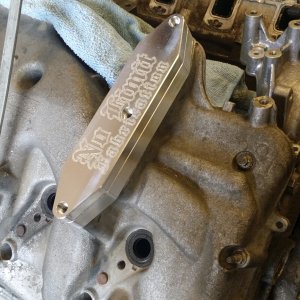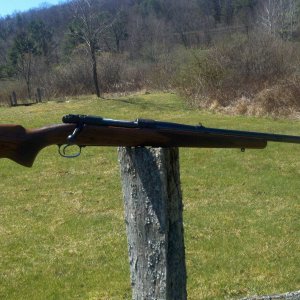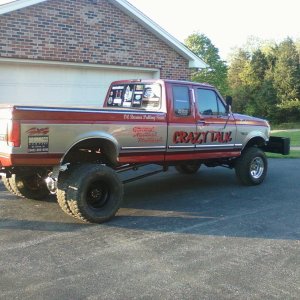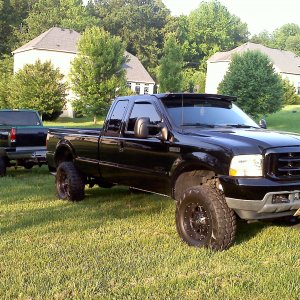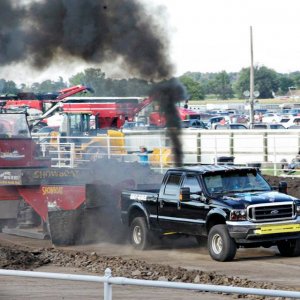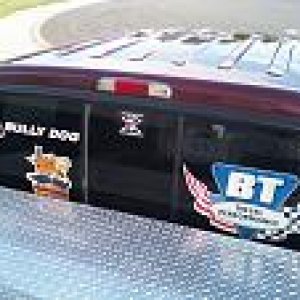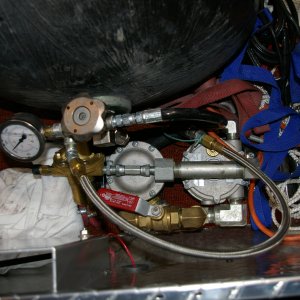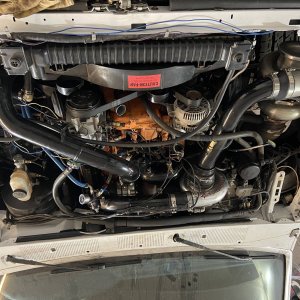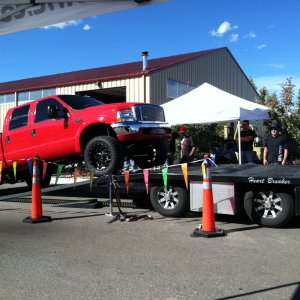Mine don't idle rough rough, they idle rougher than stock. I should more say you can notice they aren't a stock injector. The nozzles are a new size from a company who makes the majority of the nozzles everyone uses. I'm sure it can be tuned out but where I'd like icp and PW at idle it doesn't bother me. It's a comp used vehicle so i don't look for it to be like a stock truck. Also the switch from the 2675 VOP to the 3700 springs made it idle even better then before.
I know people have argued it over and over again on the bench the 2675 wins over the 3700 which should be a given. When the injector goes to open it'll open the nozzle almost 1000 psi lower and run more fuel out. I don't argue with that. My argument is the atomization of the fuel coming out. Lower pressure means larger fuel particles which come into harder to burn. Also explains why most 7.3s will burry a EGT gauge no problem. Even if you had less than 400ccs of fuel if you could make more heat energy with less fuel as apposed to more that should equal more power should it not? I.E if the injector you're using is dumping 400ccs but you only have enough time and heat to burn 290ccs of it as apposed to a 350cc injector with enough power to heat and burn all 350ccs.
That theory applies to every other diesel platform in the aftermarket except the HEUI market. Even though they might flow more doesn't necessarily mean they make usable fuel. You could lob off the bottom of a nozzle and stick it on the flow bench, it'll flow stupid numbers but won't run worth a crap once in the engine. That is another question unexplained as how when you do the equation of injector pressure a hybrid has lower pressure more fuel but guys will argue you have more pressure because of the volume of fuel at the nozzle because of the time it takes to empty. I don't see how more fuel with less pressure equates to more power. I'm sure it was fine years ago when 500hp was big numbers but seeing as you could theoretically push a HEUI injector to peak at 25K+ injector pressure why it wouldn't be explored.
I didn't say you had to make it work all day like that but for pulling or 1/4, 1/8th mile it should be fine for 30 seconds or less! I might be 100% wrong but it's not like I could spending my time doing something else hah! I just look at the common rail injection system which is what I was trained and know to make larger numbers with and have dropped rail pressure 5-6k like a A code to a hybrid does on a HEUI system and the HP numbers and particulate output look like a dirty old 7.3 or 6.0.
There are other effects to increasing VOP PSI. When VOP goes up the later the injector opens, and the shorter Injector Pulse Width (read: ACTUAL TIME, NOT REQUESTED TIME that the injector is delivering fuel). It creates a delay. I know Nate and I am sure Swamps and other injector manf tested these and while you noticed a difference in the idle sound they did not see benefits in power or off idle performance.
I am in no way saying that on the street and certainly at certain PW and ICP the b code cannot outflow a hybrid. For that matter a given set of parameters an A code can beat both of them all things being equal. It would not make much of a difference as it would not net you much but still A codes can tech outflow the others at certain a set of conditions.
One issue is you can only put so much CP and thus tq to a engine before you rip it apart not to mention you can only use so much power a given level or your just spinning your wheels. You have to widen the RPM band and that means as you need not only fast injection rate itself for say a single pulse but you need decreased time to get the injector primed to fire again. As that time shortens the A code goes from first to second and then to last. The B code goes from second to first and then to second again. The hybrid goes from last to second and then to first. B codes based on this are sort of middle of the road. That could and can possibly be a good thing for some people. Actually many street trucks that is if they have big oil. The nozzle size also comes into play as well. Because as the limiting factor moves away from the nozzle as it gets bigger it puts more demand on the oil side.
Say a hybrid and B code with 100% nozzles. The B codes are going to win as the nozzle is still the limit on flow not the oil. Move to 200% and we are just past the tipping point. Move up past that and hybrids are clearly pulling ahead. The faster the fuel can flow thru the nozzle the faster the oil side has to move. In an ideal world the nozzle would always be the point of restriction limit and we would always have as much flow capacity for a max fuel pressure as needed or any injection system. This in part why CR blow the doors off and at the same time and drive like stock with a tune change. With our HEUI the oil at some point as PW shrinks can not keep up with flow rate to keep pressure up to drive the piston down fast enough for the given time and thus you get lower injection pressure which translates to less fuel being injected. This eventually happens to all of the injectors just at different PW ICP demands. The hybrid can make it the farthest before it hits this limit as its has the lowest hydraulic ratio.
The hybrid is a bit harder to tune ( more to alter from stock). ICP ramp up etc.. Not that it can not be done easily it just that it takes more knowledge of ICP to PW etc at low demand levels etc and abit more tinkering. Thus tech B codes are easier to tune but to get a hybrid to flow the demands of a B code you increase ICP and ramp up for the PW at the lower demand levels / broader PW. This negates the advantage of the B code ratio for better fuel pressure injection. But it takes tuning to do it.
You can not take tuning for a hybrid with 200% nozzle switch to B codes same nozzle size and call that a fair comparison. Both need to be tuned differently and the hybrid will be the most effected as its farther away from the stock A code ratio.
It all comes down to what is going on the oil side. The pressure drop from and time to fill effecting piston speed and then time refill again.
What people forget is if the engines both have enough HPO ie big oil then there are not HUGE differences between B codes and Hybrids flow rates until nozzle siz gets larger. But then at the smaller nozzles you can go with less hpop if you are going hybrid. There is far more variation in each trucks setup that would mask any comparisons IMO on peak HP etc until you pass 200% threshold from what I have seen reported. Maybe peak RPM HP and TQ are made at but again this assume tuning that was well worked out on both to push thing to the max. Best done on a engine dyno with only injector swap and tuning changes.
B code can make great injectors especially on a street truck but if we are talking about which will give the best perf a hybrid wins. Once you get into the 300-400% nozzle size the hybrid pulls away clearly.
Another thing it seems some people ( not speaking of you 96F350KID) is that the injector capacity does not indicate in any way how much fuel is actually be used other than it can not be more than the capacity. It should always be less as its not good to set injectors to fully empty. Thus just because a person has 400cc injectors does not mean in anyway that is what they are injecting @ say 2ms pw. I hope no one honestly thinks my 200% 465cc are actually injecting 465cc LOL Maybe in 4+ms :doh: Its was done for other reasons and possible later nozzle swap.
Another thing to consider is the HP vs TQ levels made with B codes vs hybrids. What tq level stock rods could take before coming apart? That is another area why its better when you can fuel up high as it means lower CP and TQ for a given peak HP rating. Think of the TQ and CP it takes to make the same peak HP number at 2700 rpm vs 3700 rpms. Just an example not real numbers. When you can fuel higher you can hold fueling down lower keep CP and tq lower as you can keep fueling up top extending the power band which nets more HP.
Here are a couple posts by HRT and one by Charles that say it way better than my ramblings and bumblings...
http://powerstrokearmy.com/forums/showthread.php?t=4087
Originally Posted by Tim @ P.I.S. View Post
It was a stock BI injector with a stock BI tip. This was from an IH 6 engine.
And it really doesnt matter, because even with a 400% nozzle on it the results would not have changed an awfull lot.
I have been meaning to ask you, who's bench do you use to test your injectors on??
Are you saying that you don't see any appreciable gains in flow rate at any particular ICP and PW combination using a 400% tip over a stock BI tip? Or are you saying that B-codes don't perform as well at RPMs as say a hybrid injector with a similar displacement and tip? I guess I'm now a bit confused as to what your point of the first post even is.....
At low ICP conditions at a particular PW and tips size the A code will outflow the B code will outflow the Hybrid. At high ICP conditions at a particular PW and tip size the hybrid will outflow the b-code will outflow the A-code. Generally speaking that is. Variations in loss of flow as RPMs increase on an injector at any given PW and ICP is more of an issue with injector and test setup. There are both internal and external things that can be done to help with the loss of flow at RPM.
Looking at a split shot injector like a BI is also not a real good way to really understand how these injectors work - that split shot function adds a couple of variables to the mix that just complicates the matter. Simplifying the setup to a single shot injector removes those variables.
I use data from multiple benches - most notably my good friends Cass's bench at Full Force and Nate's bench at Unlimited - but have had offers in the past from other performance injector builders as well. Its interesting the variations I have seen in testing working with two shops like this independent of each other. I can tell you that running the same set of injectors on each bench under the same conditions will not show you the same flow data - but both benches will show improvements from injector modifications when comparing that data to previous data done on the same bench - and both benches will allow someone to build, flow, and balance a set of injectors just fine. These variations are due to construction differences between the benches - its much like seeing the difference in two trucks with the exact same setup - but one setup produces more power than the other for no readily available reason. I've been very careful to not share any proprietary info between the two shops - and I can tell you that both go about the building and setup process differently - not that one way is better than the other - just different. I use injectors from both builders in trucks locally.
http://powerstrokearmy.com/forums/showthread.php?t=4087
Originally Posted by dzldoctor View Post
I was under the impression that the b-coes were not quite as good in overall driveability. Maybe just need the tunes tweaked. Anyone live tuning near MN???
Say what? That is utter internet nonsense. Look at it in these simple terms - a stock injector runs a 7:1 injection ratio - a B-code runs a 6:1 injection ratio - an A-code runs a 5:1 injection ratio. If you put the same tip onto all of them - the A - code will always fuel the hardest at low ICP levels and the Hybrid will fuel the hardest at high ICP levels - the B-code falls squarely in the middle. Granted - not many guys are running around with A-codes with 200% tips - which might be a small part of the issues you are experiencing - the larger the injection tip - the less resistance at the tip - the higher the flow rate - as the flow rate increases the pressure drop for the high pressure oil flowing across the injector poppet increases. This is why you can have the three injectors listed above - all running say 3K psi - and the hybrid (the one with the lowest injection ratio) will actually have the higher injection pressure at the tip. This has been proven on the bench time and time again - and I am actually gathering info to do a nice write up about this exact phenomenon right now to further explain its implications and consequences with pretty graphs and pictures.
Due to pressure drops contained inside the injector - if you had three injectors, one an A-code, one a B-code, and one a hybrid - and all three were IDENTICAL other than the injection ratio - the A-code would preform with the highest injection pressure at low ICP, long PW conditions - the Hybrid would perform with the highest injection pressure at high ICP, low PW conditions - and the B-code would be a somewhere in between on both accounts. A b-code makes for a nice well rounded injector - and A-code makes a great low end, beginner injector, and a hybrid makes a good all out performance injector.
Jason
Nah - I'm definitely not Mr. Know it all - but I am fairly entertained at the bantering between Lott and Chuck at the moment. LOL
Charles has a very valid point that he is trying to press - and I for the most part agree with him and that theory of operation. The B-code is less of a change from an A-code than going to a hybrid - making the tuning easier, and making it a fairly easily "balanced" injector out the gate for DD and race duties. I do like them - but I do fully believe that the hybrid has significant advantages. I actually have been gathering flow bench data to do a nice little write up about injection on here - but time has been sparse and the benches have been super busy. The information I intend on posting will give plenty of data and examples as to what each injector is capable of under certain circumstances.
For example - I already stated that down low in long PW, low ICP conditions the b-code flows more fuel all things being equal - but in low PW, high ICP conditions the hybrid flows more fuel all things being equal. In order to get the hybrid to flow the same fuel per time at the long PW, low ICP scenario - its just as simple as a bump in ICP.
Now to understand where Lott is coming from - the B-codes with say a 100% or a 200% tip are a pretty decent compromise between performance and stock characteristics without rocking the tuning world. The b-code truck in his scenario "runs" away from the hybrid truck is entirely tuning related - the factors that effect this are ICP, PW, and ICP ramp rates - if you are limited mechanically as to how fast you can ramp the ICP - then you might not be able to tune the hybrid to keep up (but on anything with "big" oil this should not be an issue at this level of discussion).
Unfortunately I don't have any data that directly correlates at this moment - so I need you to use your imagination on this graph:

Lets just start with one simple concept: Instantaneous Oil Flow (OK so maybe not that simple - LOL)
In order for two different injectors that are completely identical in every way other than the injection ratio (intensifier piston to plunger diameter) to flow the same amount of fuel in a given time - they have to have the exact same injection pressure - its the classic flow through an orifice fluid dynamics question. The orifice sizes are the same and the flow rates are the same - so that means the pressures must be the same. In order to get the same injection pressures between the two injectors - you might have to have a higher ICP on one injector than the other - at high ICP conditions this actually means the higher injection ratio injector needs to have the higher ICP than say the hybrid - SAY WHAT??????? Yep thats right - as the oil flow rate through that poppet increases (to take care of the higher injection ratio - it must flow more oil per time in order to flow the same fuel flow rate) the pressure drop across the poppet increases - Let me explain:
Suppose I have three injectors - an A-code (7:1), a b-code (6:1), and a hybrid (5:1). Suppose that each injector give me 200cc of fuel in say 2ms. Don't bother asking about the math right now - I don't have time to explain - these are hypothetical numbers and as such should be used as an example.
........... ICP Pressure drop across poppet Injection Pressure
A-code 3164. 1200.................................... 13,750
B-code 2891... 600...................................... 13,750
Hybrid 2800..... 50...................................... 13,750
On a side note: I hate the lack of formatting control I have on here.... WTF? It wants to drop all of the spaces that makes this post look nice and clean in my little "table"

Picture the b-codes injection volume on that graph to be a bit higher on the low ICP end of things and a bit lower on the high ICP end of things and dead even somewhere in the middle. That is how they compare in reality.
Just to toss some fuel on the fire.
In terms of performance - the A-code would be the lowest, the B-code middle of the road, and the Hybrid is at the top. Now that is coming from someone that thinks a stock tip is useless, a 100% tip is OK for a working man's truck, and a 200% tip should be the staple of anyone thinking about doing anything with their truck competition wise and still be able to daily drive and tow.
That whole previous statement kind of flys in the face of traditional PSD performance - but traditional PSD performance is where bottom ends wouldn't hold together in the 500HP range at all. Look at the reasons behind the failures and correct the issues directly - you might take a different look at what you have and the direction you go.
Just imagine how fast you could have went with the right set of hybrids in those trucks.
I can stick up for the B-code a bit when it comes to injection control for DD ability - but I can't stick up for it at all when it comes to all out power.
Quote from Charles that I think gives a good basic explanation of the issue and what is happening on the oil side and thus why we actually get better perf if we drop hydraulic ratios. Do not forget that we have control over ICP pressure and at low demand times we can offset the difference of hydro ratio with increase ICP.
To summarize...
The people that actually understand injectors would LOVE to have an injector with a hydraulic ratio BELOW 5:1......Why do they not pick them? Because as you travel farther and farther down the hydraulic ratio spectrum from hybrid at one end, toward reverse hybrid at the other, the available injection rate keeps DECREASING. The available oil flow rate INTO these injectors is FIXED! The poppets are all IDENTICAL. So for any given pressure and whatever you want to do to the oilsides, they will flow _____ oil per millisecond. PERIOD.
Well, with that amount of oil, the hybrid will fill the void above it's smaller intensifier piston FASTER than the B-code will. It will also stroke that piston FARTHER down the bore than the B-code will, meaning that with both having IDENTICAL plungers, the hybrid has just moved more fuel per unit time. For anyone not up on current events, the one who moves more fuel per time across a given nozzle MAKES MORE POWER. The efficiency is HIGHER, the quality is HIGHER because the atomization and injection pressure is HIGHER.
This is because with any decently competitive nozzle the plunger is dropping faster than the oil can fill the chamber above the intensifier piston at full pressure. So.... the pressure differential keeps growing between the head rails and the chamber above the intensifier as the nozzle gets bigger and bigger. At around a 200% nozzle and at or above ~2800psi the plunger/intensifier are dropping fast enough that the pressure drop above the B-code intensifier is so great that the resultant pressure in that chamber is so much lower than the pressure inside the same chamber of a hybrid that even the greater surface area for the B-code intensifier CANNOT make up for it, and the resultant force applied to the plunger forcing the fuel across the nozzle is then LOWER for the B-code than for the hybrid!!!
This is reality. Everyday, any day, all day.



